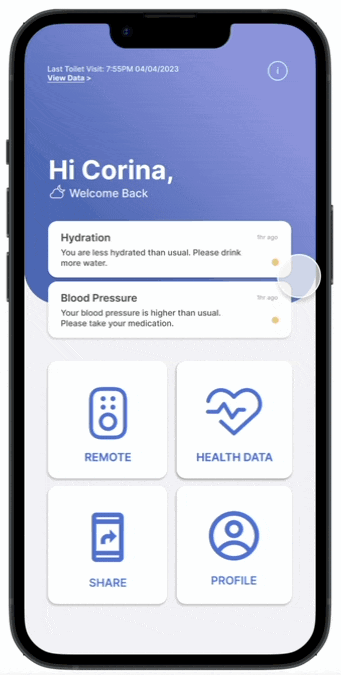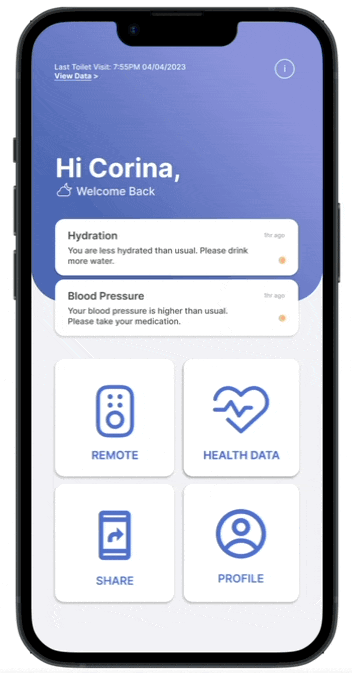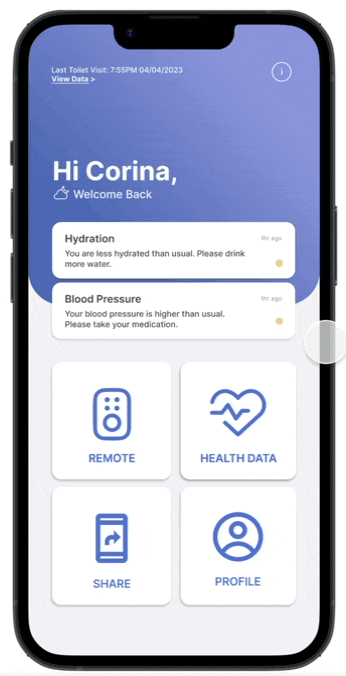No.3
Utilizing a new toilet technology to passively track and monitor health
TIMELINE
12 weeks (Feb-April 2023)
TEAM
Abby Kirchmeier (Researcher, UX Designer)
Kathleen Chen (Researcher)
Angela Clemente (Researcher)
Helen Jiang (Researcher)
TOOLS & SKILLS
User Research, Usability Testing, Wire-framing, Information Architecture, Visual Design, Figma Prototyping

TLDR
Problem/Opportunity
Washington University in St. Louis seeks to develop an interface for undergraduates, enabling them to utilize a new health technology on campus to ease post-pandemic health concerns.
Solution
I crafted a mobile interface enabling students to:
-
Monitor and evaluate health metrics based on individualized goals and preferences.
-
Receive alerts for any irregular health biomarkers.
-
Share pertinent health data with caregivers and medical experts.
-
Elevate their restroom experiences through integrated Smart Feature controls.
Impact
Implementing this tailored interface will significantly reduce students' health-related anxieties, fostering a safer post-pandemic campus environment and enhancing their overall university experience

DISCOVERY
What is a Precision Health (PH) Toilet?
A Precision Health (PH) Toilet is a technologically advanced toilet that uses sensors and machine learning algorithms to analyze urine and stool to monitor overall health and detect early signs of disease.
It's essentially a regular toilet but the seat is outfitted with various gadgets such as a motion sensor, pressure sensor, urinalysis strip, and stool camera (Yikes! I know!). With this technology, one could not only ensure they're receiving proper hydration and nutrients, but also detect health abnormalities such as urinary infections, kidney failures, COVID-19, and even some cancer
It's passive, convenient, and decreases health-related stress; however, there are great data privacy and metric accuracy concerns among the public.

User Research
My team conducted interviews with 8 undergraduate students at WashU, and 3 field experts – one of which was Dr. Seung-min Park, the inventor of the PH Toilet. In addition, we administered a survey to 69 WashU community members which included students, faculty, staff, and alumni.



Survey to understand users' comfort levels with data collection.
Interview Scripts & Responses

Card Sorting activity conducted with undergraduate students.
Key Insights


Our team used affinitiy mapping to make sense of our interview and survey responses. Here are the 6 key insights we gathered:
1. PH toilets are for everyone – Experts believe the PH toilet is useful for health monitoring and should be used by all demographics.
2. Telehealth is comfortable – Most community members are already comfortable with health tracking and telehealth communication.
3. A tool, not necessity – The product isn't in demand among students, as most are healthy and unconcerned about their well-being.
4. Privacy Concerns – About half of students are not interested in using the PH toilet, primarily due to privacy concerns.
5. Limited Health Education – About half of students are keen in using PH toilet, but limited health education hinders their data comprehension
6. Interest in Smart Features – Overall, students are more interested in Smart features (automatic flushing, seat heaters, etc.) over PH features
DEFINE
User Persona & Journey Map


Design Principles
At this stage, our team asked: What would a successful solution do? Based off of our key insights and user persona, we determined our solution would need to:
1. Ensure security and data privacy
2. Be accessible and convenient with features for healthy and diagnosed individuals alike.
3. Educate users so they can utilize their data to create healthier lifestyles
4. Create comfort by allowing users to choose what data they’d like to track and share
5. Create comfort by integrating desired smart features
DESIGN
Wireframing & Usability Testing
I began ideating initial designs and used these assets to test my concept with a group of 6 users. Beyond basic usability, I explored variations of the home page and assessed whether these designs aligned with the previously stated design principles.



Home page, versions a, b, and c


Biomarker page
Profile/Settings
All users successfully executed every instructed action. They favored Version C of the home page, as its uncluttered design helped to reduce navigation anxiety. Two design principles seemed unmet to users: health education and data privacy. While they appreciated the biomarker page's visualizations, they wanted to understand more. They asked questions like, "What is the significance of tracking certain biomarkers?" "What is considered normal or average?" and "Overall, am I healthy?" Additionally, the platform lacked clear indications of security. Many users expressed a desire for explicit assurances (in writing) regarding data privacy and security.
Revised Prototype
I introduced a new screen giving users a comprehensive view of their selected biomarkers, complementing Version C of the homepage. I also incorporated sections for statistics, analytics, and frequently asked questions to give a greater understanding of the biomarker. Finally, to create a personal environment that fosters a sense and security, I added "info pop-ups" to assist users if they're unsure about a page's purpose.

Home page

Info pop-up

Biomarkers overview

Biomarker page

Profile & Settings
Information Architecture
At this point, I finalized the information architecture. I also chose the name "No. 3," for the app, signifying that after Number 1 and 2, your third step is to check your health data!

FINAL SOLUTION
Passively Monitor & Evaluate Your Health
Effortlessly track various health biomarkers simply by using the restroom! Receive alerts when any biomarker strays from your norm, along with guidance to maintain your health.

Share Your Secure Data With Caregivers & Medical Professionals
Sharing data with caregivers and medical professionals can greatly aid your health care journey. No. 3 protects your health data, and it can only be shared with your explicit consent and with those you trust.

Customize According to Your Health Needs
By sharing demographic and health history details, you can enhance the system's precision in evaluating your well-being and tailoring recommendations.

Elevate Your Bathroom Experience
Health monitoring can be comfortable and fun with the comfort of Smart Features such as heated seating, automatic flushing, and colorful lighting.

INSIGHTS
Challenges
The greatest challenge was finding a data-driven aspect to the project. While the illustration styles will be tested in Q4, we wanted insights to guide initial exploration. Some company resources were unavailable, so instead, I directly reached out to internal Devs and PMs for stakeholder insights.
Key Takeaways
The development of "No. 3" underscored the importance of clear, user-centric design, especially in areas as sensitive as health and privacy. Robust information architecture was crucial for intuitive user navigation, and transparent communication was essential to building user trust. Merging user input with advanced analytics for tailored health insights demonstrated the efficacy of the integration of demographic and health history. The experience also emphasized the importance of empathy and adaptability in user research, showcasing that sometimes the researcher's demeanor can be as impactful as the design itself in obtaining authentic feedback.